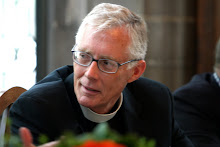I came (or should say “returned”) to Christ Church Cranbrook in January of 2010, and one of the things I’ve given most thought to in these two years is communications. We all live in a fragmented age, and each of us is bombarded daily with hundreds, if not thousands, of messages claiming our full attention. How does a church foster communication among its members? How do leaders (clergy and lay) communicate with parishioners? How do parishioners keep abreast of rector and vestry actions? How do we get a real sense of what people think or feel about the way things are going?
I came to Christ Church having thought a lot about communications in my previous job. During my time at Seabury, the seminary I served as dean and president, we found it necessary to face into changing economic and ministry education realities. As the school took them on, it had to change itself from one kind of seminary to another, and the single most important aspect of navigating the change was communications. People “out there” thought the school was closing when it wasn’t. Getting our message out and hearing back from our graduates and friends was an enormous challenge.
Though Christ Church Cranbrook does not face precisely the same problems that a seminary does, all faith communities in the 21st century face real challenges: social, economic, and demographic changes to our area, declining attendance patterns at all mainline Protestant churches, widening generational preferences about liturgical and musical style, increased competition across denominational “brands”, the difficulty of finding time for church in overscheduled lives. In my years working on church growth in Pasadena and teaching Congregational Development in Evanston, I learned that churches that keep doing the same thing and expect people to show up do not have very good chances of survival. But how does a church make significant adaptive changes while remaining true to its essential ethos? How do we attract new people and continue to serve our present members?
I don’t have all the answers to these questions, but I do know that communications is central to how we face into them. Over the spring and summer, the Vestry and staff leadership worked with a prominent church consulting firm, Canticle Communications, to help us evaluate and rethink our communications processes. (It was largely as a result of our work with Canticle that we decided to make Communications a full time senior staff position and asked Peggy Dahlberg to take that on.) The consultants helped us think of new ways we might sharpen our message both within the parish and to the outside world. And they gave us insight into how we could get a dialogical conversation going between rector, vestry, staff, and congregation.
Hence this first installment of “The Rector’s Monday Message”—a title I have borrowed from my friend Jay Sidebotham’s church in Lake Forest, Illinois. We will continue to send the weekly “Communicant” email on Thursdays, and that newsletter will feature articles by other staff and lay leaders about issues and events in our common life. We will begin the week, each Monday, with an email letter from me. The purpose of this Monday Message is twofold: to begin a conversation about my vision for Christ Church Cranbrook and to invite you to share your ideas, responses, and concerns. The Monday Message will come from me, and you will be able to respond to me directly by hitting “reply”. Sometimes these messages will be thoughtful reflections on life and faith; sometimes they’ll contain ideas about parish priorities and values; sometimes they’ll engage simple institutional housekeeping. My goal for this vehicle is that it foster greater dialogue between and among us.


No comments:
Post a Comment